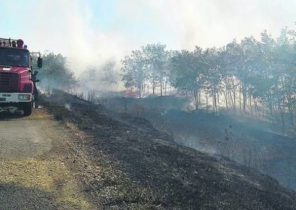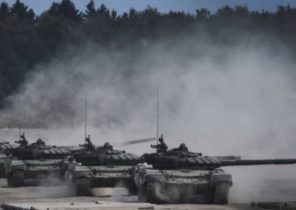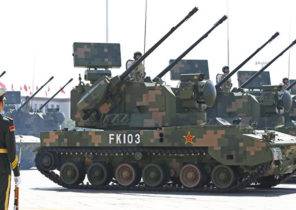The Soviet legacy
Recently, at the request of Ukraine, Estonia gave us 2 thousand 400 Makarov guns, which had been in service with the Estonian army. In response to the request, the Minister of defence of Estonia noted that thus his country’s support for an ally who is at war for six years.
Self-loading pistol developed in the USSR after the Second world war and entered service in the distant 1951. After the collapse of the Union of PM continued to serve in power structures of post-Soviet States, the former Soviet bloc countries and also some States of Asia, Africa and the Middle East. Now the Estonians gradually get rid of these guns in connection with the transition to NATO standards. Ukraine also announced the transition to the standards of the Alliance, but is forced to accept a gift from the allies obsolete weapons.
Delivery of the Makarov pistols from Estonia shows once again that in the sixth year of the war, despite individual successes in the creation of high-tech missile weapons (“Alder” and “Neptune”), Ukraine is not yet able to independently provide for its troops in conventional arms. It is not only Makarov pistols, but ammunition of their own making — ammunition and projectiles of different calibers.
Being involved in a war in the Donbas, Ukraine found itself in an ambivalent situation. On the one hand, inherited from the Soviet Union, we received substantial stocks of Soviet weapons and ammunition, on the other hand, has repeatedly stated that the transition to the standards of the Alliance. Soviet ammunition differs from NATO. For example, the regular caliber cartridge under the Kalashnikov AK-74 is 5.45 mm, and under the American rifle M16 — 5.56 mm. Heavy artillery of the member States uses NATO caliber 155 mm, and the Soviet (at the disposal of APU) — 152 mm. in Other words, Soviet ammunition for Western weapons are not suitable.
Therefore, it is useful to develop the production of munitions, given NATO items. On the other hand, it is necessary to compensate for the consumption of ammunition, shells and missiles of Soviet manufacture, time spent in combat operations in the Donbass. In the end, in the seventh year of the war, Ukraine does not yet have a full cycle of production of their own ammunition neither NATO nor the Soviet model.
Artillery shells and missiles
Before the war on the Ukrainian warehouses and arsenals, there were more than 2 million tons of bombs and missiles that we inherited after the collapse of the Union. A significant part of those munitions with expired shelf life. This was stated in 2004 during the aftermath of the explosion of the Arsenal in Novobohdanivka (Zaporizhia region). It was then discussed that the utilization be about one and a half million tons of bombs and missiles. Obviously, this was due to the fact that in the prewar years due to insufficient funding in Ukraine is almost not performed maintenance and repairs of practically all items available ammunition.
The regular explosions in artillery warehouses also exhausted Soviet stockpiles. For example, the explosion in Balakliya and Kalinovka in 2017 and in Ichnia in 2018, apparently, suffered artillery ammunition for ground artillery of calibre of 100 mm to 152 mm. All this forced the troops conserve ammunition during the fighting. Even the army began to be felt shortage of ammunition for all types of artillery, including reactive. According to experts, if the intensity of the fighting in the Donbass once again reach the level of the summer of 2014 or winter of 2015 and will continue for several months, the Ukrainian army may not have any artillery or tank shells. Against this background, depreciate any achievements of Ukrainian defense and becomes meaningless any war.
Attempts to overcome the “boepripasy hunger” being taken for several years. So, in may 2017 was approved the state target program for the creation and production of ammunition and special chemistry products for the period up to 2021.
I note that the standard artillery projectile consists of a fuse body with military explosives, the sleeve with a propelling powder charge, and percussion cap sleeve with means of initiation of explosion. Closed cycle of production of artillery shots were created in Ukraine through cooperation of various enterprises.
In 2019, the state holding company “Artem”, which is included in the state concern Ukroboronprom has mastered production of 152-mm of an artillery shell. In the same year, was the serial production of 300-mm guided missile “Alder” for the same missile, developed by the Kiev KB “Ray”, was completed work on the modernization of 122-mm jet systems of volley fire “Grad” project “willow”. The explosives were prepared to ensure the cooperation of enterprises created on the basis of the NGO “Pavlograd chemical plant”.
At the end of 2019, Ukroboronprom reported that shostkinsky state factory “Impulse” launched a production facility for the production of all the necessary details for initiating artillery shells and missiles. With the opening of these facilities on the “Impulse” was established full-cycle production of artillery ammunition and missiles, able to meet the needs of the defense Ministry.
However, in Ukraine there was a problem with the production of gunpowder and propellants. It happened because in the pre-war years Shostka gunpowder plant “Zirka”, which was previously provided artillery propelling charges of the army of the States of the Soviet bloc, went into decline. In 2019, said on the resumption of the production of gunpowder in the “Zirka”, even if based on imported raw materials. Information about how successful were these attempts, no.
Cartridges
If the production of artillery ammunition there were certain achievements, with cartridges for small arms — everything is much worse. Before the war, ammunition of caliber 5.45 and 7.62 mm manufactured Lugansk cartridge plant (LBP). In June 2014, it took control of the militants of the so-called “Luhansk people’s Republic”.
Information about the further fate of the enterprise is highly controversial. According to one, equipment LPZ were exported to Russia. Was information that in late July 2014, Ukrainian air force struck at the LPZ to ensure that his capacity was not used by the separatists. However, in 2016 and 2017, the militants said about the attempts to restore the plant in the production of ammunition. If they managed to achieve any success is unknown. In any case, the LC and the DNI does not really need their own cartridge manufacturing — all required in abundance comes from Russia.
As for Ukraine, talks about the construction of the ammunition factory was carried out in 2014. So in the fall of 2014, the then Director General of Ukroboronprom Roman Romanov promised that Ukroboronprom plans “within two years to build a modern plant for the production of shells and cartridges”.
Despite all the promises, in 2016, the plant was never built. But in 2017, President Petro Poroshenko promised again to still build in Ukraine cartridge factory, which would produce products that comply with NATO standards. Was named and construction estimates 1.4 billion hryvnia.
After this statement about the construction of the munitions plant was not audible almost half a year. Finally, in December 2018, it became known that at Vinnytsia state enterprise “Fort”, which is the responsibility of the Department of the interior, the line was launched a full cycle of production of pistol cartridges caliber 9×18 mm 9×19 mm.
It was noted that the production line can produce up to 14 million rounds a year. The equipment was bought in the Czech Republic, Poland, Turkey and the United States. According to the Minister of internal Affairs Arsen Avakov, in the future, “Forte” can be deployed trade and other ammunition for small arms calibre from 5.45 to 14.5 mm.
These plans did not come true, because in March 2020, the SBU reported about the facts of mass embezzlement of funds at the “Fort”. It was noted that the newest machines that were purchased for the production of ammunition, in fact, made at the beginning of the last century, technically faulty and does not meet the conditions of the contract. As a result of the abuse was allegedly disrupted the supply of scarce ammunition for the armed forces of Ukraine.
It is believed that Soviet ammunition in Ukraine is still enough to wage war in the Donbass with a low degree of intensity. However, the bullets need not only to shoot at the enemy. Munitions expended during exercise, so that, in any case, their stocks gradually come to an end. Deficit are trying to eliminate, including through external supplies. One of our partners was Lithuania, which in 2015-2019 gave Ukraine small arms and several million rounds of ammunition, made in the USSR. However, the problem with private production of ammunition, shells and rockets need to solve as soon as possible, otherwise even the low-intensity conflict, sooner or later will leave us unarmed.







